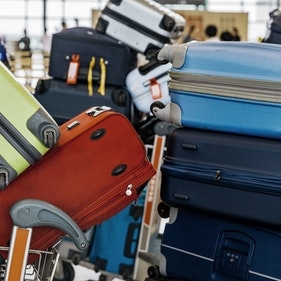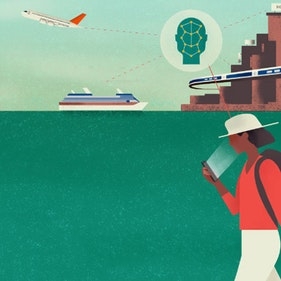This article was first published on June 23, 2020.
For the foreseeable future, COVID-19 considerations will dominate travel planning. Both governments and travelers are desperate to ensure that as travel resumes, it is both healthy and safe. The situation presents a unique opportunity for the public and private sector to work together to fast-track global standards for traveler digital identities.
Increasing health and safety across the travel ecosystem involves two critical needs: First, a touchless experience across all journey touchpoints. Second, the ability to share traveler information (such as identity, health, and travel history) in a secure manner with government agencies and travel providers. Both could be achieved with a biometrically enabled “trusted traveler” digital identity profile.
Governments, industry associations, and travel providers must join forces and take immediate action to define standards for each component of the traveler digital profile. A collaborative effort will ensure interoperability and international recognition of traveler digital profile solutions.
Touchless travel: the traveler digital identity profile
While groups like the International Air Transport Association have been focusing on improving the flow of people at airports and across borders, the broader travel industry has been working to better integrate the entire travel experience. For example, the World Travel & Tourism Council’s Safe and Seamless Traveler Journey program has been working closely with governments and travel and technology providers to build a blueprint for globally secure and interoperable touchless journeys (for both air and non-air travel).
Traveler information has become increasingly digital over time – from bookings to boarding passes. The traveler digital profile would be the final step: a fully digital form of any paper information travelers still carry, such as personal identification, rounded out with additional information now vital in a post-COVID-19 world, such as health and travel history. To ensure global usability, it will be critical that all of the information in the digital profile can be internationally recognized. To establish international trust in the digital profile, data must be securely linked to the traveler’s identity using biometrics and must originate from trusted, government-authorized sources.
A traveler’s digital profile would consist of several digital “containers” that store various groups of information, such as:
- Biographic and biometric data derived from government-issued identification, such as a machine readable e-passport, driver’s license, or identification card; and a live face capture (compliant with international standards)
- Health certification, including vaccinations, immunizations, and testing
- Recent travel history, possibly including contact tracing scores. Travel history must include travel across official and unofficial borders within large countries (such as states within the United States, countries within the European Union, or regions in China). Note: Travel history standards must take into account the risk of discrimination by border agents.
- Immigration visa or other immigration documents
- Payment information and loyalty program credentials and preferences
Stakeholders along the travel chain would have varying levels of permission to access this data, ranging from simple identification and payment for services up to complete health and travel history for border control.
Enhancing global standards
International travel relies on multilateral, consensus-driven standards to create and maintain trust between countries. These standards ensure that countries can maintain their security while facilitating the movement of travelers. For the foreseeable future, additional health protocols will need to be included, but any updating of standards must ensure that travelers will enjoy a safe and seamless experience.
To enable touchless travel globally, each component of the traveler digital identity will rely on these standards. It is important to point out the significant work that has been done to date, such as the International Civil Aviation Organization’s passport digitalization program and the International Air Transport Association’s “One ID” concept, enabling a digital, touchless experience for air passengers. These programs should be leveraged to rapidly develop interoperability for new components of the traveler digital profile.
Global standards that enable a safe and seamless journey play a particularly critical role for small countries whose economies rely on the travel and tourism sector. These countries typically do not have a stake in standards definition, but are dependent on them to keep their countries, citizens, and guests safe in a COVID-19 world.
Aruba Happy Flow
One such small country that relies on tourism is Aruba, which is already developing a touchless end-to-end solution that leverages biometrics. Phase one of the Aruba Happy Flow program enabled a touchless journey through the Aruba airport. Phase two of the program, which is currently in development, will expand that touchless journey to include arrival, car rental, and hotel check in.
The crucial program element is a biometrically verified digital identity that a traveler securely shares upon entering the country. The supporting identity management platform connects the government and travel providers throughout the traveler’s journey, only sharing the data each travel provider requires and is authorized to receive, in compliance with stringent privacy regulations.
As Aruba begins to define its post-COVID-19 strategy, it has become vocal about the opportunity to use its Happy Flow program to pilot receiving travelers’ digital health certificates and travel histories. This would allow Aruba, through a trusted and reliable source, to obtain the information deemed necessary for travelers to enter the country while keeping its own citizens safe.
Critical next steps
There are a number of steps that governments, industry associations, standard-setting bodies, and travel providers will need to take. Requirements (technical, privacy, data, etc.) for the health certificate and travel history components of the digital traveler profile must be defined, in partnership with industry experts outside of travel.
International standard-setting bodies will need to develop globally recognized standards, such as the World Health Organization for a digital health certificate and the International Civil Aviation Organization for a digital travel history.
Travel providers will need to execute two critical pieces of work: One will be to provide input into the development of standards, to ensure that they are workable for the industry. The second will be to develop their own biometric digital identity strategies, fully endorsed by their organizations. These strategies must be customer-centric, while taking into account shifting post-COVID-19 government requirements.
Travel recovery plans are already underway, with the World Travel & Tourism Council recently launching global protocols for businesses and destinations. A core component of this effort is a public-private task force to begin actioning required steps toward a globally recognized health certificate and travel history. The world has a shared goal now: to make the touchless traveler journey a reality very soon.









